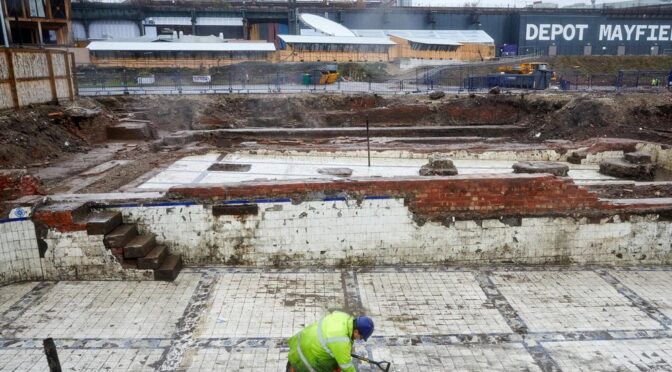‘Stunning’ Victorian Bathhouse Unearthed Beneath Manchester Parking Lot
The facility offered laundry and bathing services for 19th-century textile workers and their families.

Ahead of construction of a new public park, archaeologists in Manchester, England, have uncovered a bathhouse used by textile factory workers more than 150 years ago.
“We knew what we would be excavating but we didn’t expect the tiles to be in such good condition,” Graham Mottershead, project manager at Salford Archaeology, tells BBC News. “[T]hey are stunning.”
As Louise Rhind-Tutt reports for I Love Manchester, the baths opened in 1857, offering much-needed bathing and laundry services for workers during the city’s heyday as a center of industrial textile production. The facility included male and female pools, the largest of which measured 62 feet.
So far, researchers have uncovered two large tiled pools, boilers, flues and pumps. The mechanical systems heated water and circulated it through both the bathing and laundry facilities.
To uncover the baths’ details, archaeologists are using 3-D laser scanning and drone photography, in addition to physical excavation. The team will preserve these digital records alongside historical documents, allowing for the creation of accurate representations of the facilities.
“The sheer pace of change and innovation during the Industrial Revolution means many advancements were not recorded,” says Mottershead in a statement.
“Excavations like this help us to learn a great deal about what is arguably the most important period of human history and, in the case of Mayfield, a location that is so very relevant to the heritage of the people of Manchester.”

A history provided by the development company explains that the Mayfield area of Manchester became an important industrial center after businessman Thomas Hoyle established the Mayfield Print Works there in 1782.
By the mid-19th century, the neighborhood had won fame for its impressively quick printing of patterned textiles. At the time, Manchester as a whole was known as “Cottonopolis”—a reflection of its centrality to cloth production.
The Mayfield Baths were the third public baths built in the city. Ian Miller, an archaeologist at the University of Salford, tells BBC News that baths began as an amenity for the middle class in the 18th century but were followed by public facilities oriented toward the hygienic needs of industrial workers and their families. The city’s first public baths opened in 1846. Later, more were built, reaching a peak of 30 across the city by the late 19th century.
“Before public baths the textile workers lived in crammed insanitary conditions and would wash their clothes in the used bath water,” Miller says. “Public baths were a game changer for the health of the working classes, keeping clean and having clean clothes were essential for public health.”
The Guardian’s Josh Halliday reports that the facility remained standing until World War II, when it was damaged by bombing. It was later demolished.
More recently, the area, located behind Manchester Piccadilly station, went largely unused. The planned 6.5-acre Mayfield Park will be the first new public park built in the city in 100 years.
Per I Love Manchester, the excavation is part of an enormous effort by the Mayfield Partnership to redevelop a large section of the English city. In addition to the park, the plan includes the construction of 1,500 homes and nearly two million square feet of commercial, retail and leisure space.
One of the commercial buildings will be named after George Poulton, a 19th-century competitive swimmer and public health advocate who gave swimming lessons at the Mayfield Baths and educated the public about hygiene. The design of the building’s foyer will echo the baths’ appearance.
